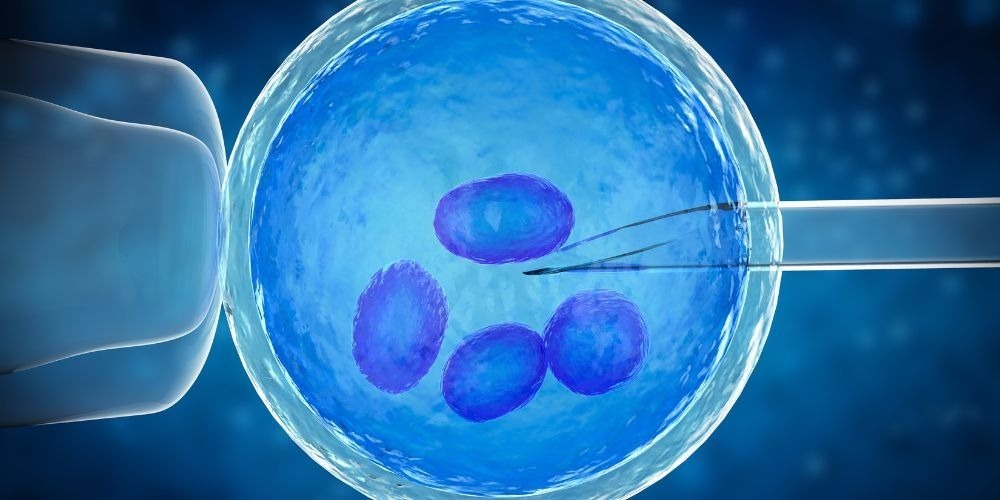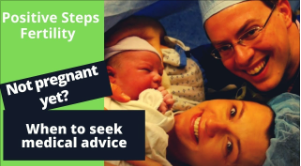Understanding the ins and outs of your fertility can be overwhelming. With so many factors affecting both men and women that can impact a woman’s ability to conceive, your head can spin with the surplus of information.
One of the areas that is crucial to fertilization, but seldom discussed in detail, is how an embryo is actually transferred by a fertility specialist. In this post, we’ll clarify the various ways embryos are transferred to the uterus in fertility treatments.
When discussing embryo transfer, it’s important to note that not all methods are as widely used or popular in fertility treatments. The main reason is that assisted reproductive technology (ART) using in vitro fertilization (IVF) has become so effective that alternative approaches such GIFT and ZIFT have been left behind for having lower success rates.
What is an embryo transfer?
An embryo transfer is a procedure that involves transferring one or more fertilized eggs (embryos) into a woman’s uterus. There are several reasons for performing IVF followed by embryo transfers, including infertility, genetic diseases, recurrent miscarriage, and other circumstances.
Embryo transfer is usually done as part of an in vitro fertilization (IVF) cycle. IVF is an assisted reproductive technology bypassing many infertility problems by combining a man’s sperm with a woman’s egg in a controlled lab environment in order to achieve fertilization. If embryos successfully develop, one or more will be placed in the woman’s womb for pregnancy.
Why parents turn to embryo transfers
The main reason future parents turn to embryo transfers is simply to overcome infertility issues. Embryo transfers allow intended parents to use their own eggs and sperm, or those from donors, to create embryos in a laboratory. These embryos are then transferred to the uterus of the intended mother or a gestational carrier, where they can implant and develop into a baby. By ensuring sperm and egg meet in the lab, as well as confirming that they continue to grow, this process meaningfully increases the chance that a healthy embryo will successfully reach the uterus.
Another reason intended parents may opt for embryo transfers is to avoid passing on genetic diseases or disorders to their children. Some genetic conditions can be detected in the embryos before they are transferred, using a technique called preimplantation genetic testing (PGT). This allows intended parents to select healthy embryos that are free of the condition they want to avoid. Embryo transfers can also help intended parents who have a family history of certain diseases or disorders, such as cancer, cystic fibrosis, or Huntington’s disease.
When screening for a specific disease, this process is called PGT-M (monogenic) because a single gene is targeted. However, when screening for broad chromosomal (DNA) multi-gene disorders which can result in miscarriage, Down syndrome, and other complex DNA situations, the process is called PGT-A (aneuploidy, meaning an abnormal number of chromosomes).
A third reason why intended parents may choose embryo transfers is to have more control over the timing and characteristics of their pregnancy. Embryo transfers can help intended parents who have busy careers, personal commitments, or health issues that make it difficult to conceive naturally. Embryo transfers can also help intended parents to plan their family size and spacing, as well as to select the sex of their child if they wish.
Embryo transfers can also enable intended parents who are single or in same-sex relationships to have biological children with the help of donors or surrogates. Moreover, some lesbian couples want to each contribute to conception and, with use of a sperm donor, IVF allows one to donate eggs and for the other to carry the pregnancy.
What is the embryo transfer procedure when using one’s own eggs or if they are donated?
When eggs are donated, there are seven steps involved in egg transfer:
STEP 1: The first step is to find a suitable donor and recipient (if not simply using oneself for the entire process). The donor and recipient should be screened for infectious diseases and genetic disorders. The donor should also have a good ovarian reserve and respond well to ovarian stimulation. The recipient should have a normal uterus and no medical conditions that could affect pregnancy.
STEP 2: The second step is to synchronize the menstrual cycles of the donor and recipient. This can be done by using hormonal medications that suppress ovulation and induce artificial menstrual cycles. The donor and recipient should start taking these medications at the same time and follow the same schedule. Of note, this synchronization has become less important since egg and embryo freezing have become much more successful. Synchronization is much more important for a fresh transfer, when now many couples have an egg-freezing timeline and perform PGT-A to screen for reasons for miscarriage before doing a transfer of the frozen embryos.
STEP 3: The third step is to stimulate the donor’s ovaries to produce multiple eggs. This can be done by using injectable hormones that stimulate follicle growth and maturation. The donor will have regular ultrasound scans and blood tests to monitor the development of the eggs. When the eggs are ready, the donor will receive a final injection (with hCG) that triggers ovulation.
STEP 4: The fourth step is to retrieve the eggs from the donor’s ovaries. This can be done by using a thin needle that passes through the vagina and into the ovaries under ultrasound guidance. The eggs are then aspirated into a tube and transferred to a laboratory.
STEP 5: The fifth step is to fertilize the eggs with sperm from either the recipient’s partner or a sperm donor. This can be done by either placing the sperm and eggs together in a culture dish (conventional IVF) or injecting a single sperm into each egg (intracytoplasmic sperm injection or ICSI). The eggs are then incubated for several days until they develop into embryos.
STEP 6: The sixth step is to transfer one or more embryos to the recipient’s uterus. This can be done by using a thin catheter that passes through the cervix and into the uterus under ultrasound guidance. The embryos are then released into the uterine cavity. The number of embryos transferred depends on various factors, such as the age of the donor and recipient, the quality of the embryos, and the success rate of the clinic. However, as PGT-A has become more common, ~85% of embryo transfers in the US are of just one embryo.
STEP 7: The final step is to wait for pregnancy to occur. The recipient should have a blood test about two weeks after the embryo transfer to check for pregnancy hormones. If the test is positive, an ultrasound scan will be performed about three weeks later to confirm the viability and number of fetuses. With single embryo transfer, the likelihood of multiples is usually 1%.
What are the different types of embryo transfers?
Gamete intrafallopian transfer (GIFT)
Gamete intrafallopian transfer (GIFT) is a type of assisted reproductive technology (ART) that can help women and couples who have difficulty conceiving a child. Of note, GIFT is technically not an embryo transfer, as sperm and egg are transferred without an embryo having been formed. GIFT involves the following steps:
- The woman takes hormonal injections to stimulate the development of multiple eggs in her ovaries.
- The eggs are retrieved from the ovaries through a minor surgical procedure called laparoscopy, which uses a thin tube with a camera and a light to view the pelvic organs.
- The man provides a semen sample, which is processed in a laboratory to separate the sperm from the fluid.
- The eggs and sperm are mixed together and placed in a thin catheter, which is inserted through the woman’s vagina and cervix into one of her fallopian tubes. The catheter contents are separated by air bubbles to prevent fertilization before the transfer. Alternatively, laparoscopy is performed for introduction of sperm and eggs.
- The eggs and sperm are released into the fallopian tube, where fertilization may occur naturally. The resulting embryos may then travel to the uterus and implant in the lining.
- The woman takes a pregnancy test about two weeks after the procedure to check if she is pregnant.
GIFT has some advantages and disadvantages compared to other ART methods, such as in vitro fertilization (IVF). Some of the advantages are:
- GIFT is more similar to natural conception, as fertilization occurs inside the woman’s body rather than in a laboratory dish.
- GIFT does not involve manipulating or selecting embryos, which may be preferred by some people for ethical or religious reasons.
Some of the disadvantages are:
- GIFT requires at least one healthy fallopian tube, whereas IVF does not. GIFT is not suitable for women with blocked or damaged tubes, severe endometriosis, or severe male factor infertility.
- GIFT usually requires general anesthesia and laparoscopy, which are more invasive and risky than IVF, which only requires sedation and ultrasound-guided egg retrieval.
- GIFT does not allow for genetic testing or screening of embryos before transfer, which may be important for some couples who have a risk of passing on genetic disorders or chromosomal abnormalities.
- GIFT does not guarantee fertilization or implantation, and it may result in multiple pregnancies if more than one egg is fertilized and implants.
- GIFT has a much higher rate of ectopic (tubal) pregnancy.
GIFT is one of the options available for women and couples who want to have a baby with ART. However, it is not widely used anymore due to the availability and popularity of IVF and other techniques. Before deciding on GIFT or any other ART method, it is important to consult with a fertility specialist who can evaluate your medical history, perform diagnostic tests, and explain the benefits and risks of each procedure.
Frozen Embryo Transfer (FET)
What is FET in IVF? A FET cycle is a type of IVF fertility treatment that uses cryopreserved embryos that have been frozen in a previous cycle.The process of how a frozen embryo transfer (FET) works is as follows:
- The embryos can be from the patient’s own eggs and sperm, or from donor eggs and sperm.
- The embryos are stored in liquid nitrogen until they are ready to be used.
- When the patient decides to have a FET cycle, the embryos are thawed and transferred to the uterus through a catheter.
- The timing of the transfer depends on the patient’s menstrual cycle and the type of hormones they are taking to prepare the endometrium (the lining of the uterus) for implantation.
- The transfer can be done either in a natural cycle, where no hormones are used and the transfer is based on ovulation, or in a medicated cycle, where hormones are used to suppress ovulation and control the endometrium development.
- The number of embryos transferred depends on the patient’s age, medical history, and preference. Usually, one or two embryos are transferred to reduce the risk of multiple pregnancy.
- After the transfer, the patient may need to take progesterone supplements to support the pregnancy until a blood test confirms if the embryo has implanted or not.
A FET cycle has several advantages over a fresh embryo transfer, such as avoiding ovarian hyperstimulation syndrome, allowing genetic testing of the embryos, and preserving fertility for future use. Ultimately, there is almost no difference in pregnancy rates between fresh and frozen transfers if one isn’t performing PGT-A. Though this varies among clinics, some clinics see much higher implantation rates after PGT-A, particularly if there is higher risk for aneuploidy (chromosomal abnormalities).
Zygote intrafallopian transfer (ZIFT)
Zygote intrafallopian transfer (ZIFT) is a type of assisted reproductive technology (ART) that can help couples with infertility problems conceive a child. ZIFT works by combining the processes of in vitro fertilization (IVF) and gamete intrafallopian transfer (GIFT). In ZIFT, eggs are retrieved from a woman’s ovaries and fertilized with sperm in a laboratory. The resulting zygotes, or fertilized eggs, are then transferred into the woman’s fallopian tubes using a surgical procedure called laparoscopy. This allows the zygotes to implant in the uterus naturally, as they would in a normal pregnancy.
ZIFT is suitable for women who have at least one functioning fallopian tube and normal ovulation, and for men who have adequate sperm quality and quantity. ZIFT may also be an option for couples who have failed to conceive with other ART methods, such as IVF or GIFT. ZIFT has a relatively low success rate compared to conventional IVF, but it also has some drawbacks. ZIFT is more expensive and invasive than IVF or GIFT, and it carries a higher risk of multiple pregnancy and ectopic pregnancy. ZIFT also requires the use of fertility drugs to stimulate egg production (as with all IVF procedures), which can cause side effects such as ovarian hyperstimulation syndrome (OHSS), mood swings, and headaches.
The benefits and risks of embryo transfers
Embryo transfers have both benefits and risks that should be considered before undergoing the procedure.
Some of the benefits of embryo transfers are:
- They can help people who have difficulty conceiving naturally due to various reasons, such as ovulation disorders, damaged fallopian tubes, endometriosis, genetic disorders, or impaired sperm production.
- They can increase the chances of pregnancy by selecting the best quality embryos based on various factors, such as genetic testing or metabolomic profiling.
- They can reduce the risk of transmitting genetic diseases or chromosomal abnormalities to the offspring by screening the embryos before transfer.
- They can allow people to have more control over their family planning and reproductive choices, such as the number and timing of children.
Some of the risks of embryo transfers are:
- They can cause physical discomfort or complications during or after the procedure, such as cramping, bleeding, infection, or perforation of the uterus. Though cramping and bleeding are common, they rarely require medical attention. Infection and perforation are exceptionally rare, and would require more oversight.
- They can result in multiple pregnancies if more than one embryo is transferred or if one embryo splits into twins. Multiple pregnancies carry a higher risk of premature birth, low birth weight, placental problems, preeclampsia, diabetes, and cesarean delivery for the mother and the babies.
- They can fail to achieve a pregnancy or lead to a miscarriage if the embryos do not implant or develop properly. This can be emotionally distressing and financially costly for the people involved.
- Ultimately, anything that can go well or be complex for a normal pregnancy can happen with an embryo transfer.
Embryo transfers are a complex and personal decision that should be made after consulting with a fertility specialist and considering all the possible outcomes and implications.
Navigating Embryo Transfer Options
Clearly, there are many options when it comes to approaching embryo transfer, and numerous fertility treatments available. But, by understanding the basics of embryo transfer, you can approach your fertility journey with more clarity and knowledge.
The difference maker, however, is reaching out to a fertility specialist. A specialist can assess your specific needs and address all of the questions that you have regarding your fertility.
Don’t suffer in silence. Get answers. Get peace.




